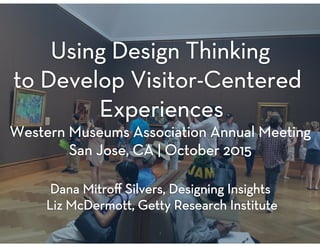
Using Design Thinking to Develop Visitor-Centered Experiences
- 1. 1
- 2. Dana Liz @lizmcdermott35 @dmitroff Welcome! Twitter hashtags: #wma2015 #designthinking
- 3. What is design thinking?
- 4. A set of methods and mindsets for framing problems & generating innovative, human-centered solutions 4
- 5. Image by the Stanford d.school The process
- 6. Empathize Define Prototype Test Ideate REPEAT! Image by the Stanford d.school 6
- 7. Image by the Stanford d.school
- 8. focus groups usability tests surveys web analytics Where does design thinking fit in? a/b testing market research formative evaluation summative evaluation 8
- 9. Helps us connect with the people + stories behind our data Wikimedia Foundation Strategic Plan Survey by Bridgespan Partners, 2009. Licensed under GNU Free Documentation License via Wikimedia Commons , CC BY-SA 4.0.
- 10. So we can understand the why, not just the what
- 11. Institutions trained in design thinking
- 12. Human-centered Bias towards action IterativePrototype-driven Collaborative All icons licensed from The Noun Project The Mindsets 12
- 13. Before
- 14. After
- 16. Get some blank paper and a Sharpie 16
- 17. 3 min on your own. Go!!!
- 18. That was a problem-solving approach
- 19. Image by the Stanford d.school Now, a design thinking approach…
- 20. Get a new partner Not someone you already know!
- 21. How might you make your museum* comfortable and welcoming for your partner? *or any museum of your choice if you don’t currently work in a museum!
- 22. Your mission is to discover what comfortable and welcoming means for your user.
- 24. Empathize: what?
- 25. Empathize: why?
- 27. Immersion Image by Maryanna Rogers
- 29. What? How? Why? Ethnographic Interviewing
- 30. Interview best practices Encourage stories Use open-ended questions Always ask “Why?” Allow space for silence Take notes!
- 31. Interview your partner Tell me about a place where you feel comfortable and welcome. o Where is it? o Why do you feel that way there? Tell me a story about a recent experience in which you felt uncomfortable and unwelcome somewhere. 2 sessions x 4 min each
- 32. Follow-up and go deeper “Why did you say…” “Can you say more about…” “Do you have another example of …?” “Really? And why was that?” “Why? Why? Why?” 2 sessions x 4 min each
- 33. 33
- 34. If I had 20 days to solve a problem, I would take 19 to define it. -Albert Einstein
- 35. What is the real need?
- 36. 36
- 38. Human emotional and physical necessities. Verbs, not nouns Opportunities, not solutions Needs are…
- 39. Something you can see from the outside that your user cannot see. A contradiction, a surprise, an “aha!” Why do you think your user has this need? What’s really going on here? Insights are…
- 40. Needs + insights mapping Insights: What + why behind the needs Needs: Verbs, not nouns
- 41. Needs + insights mapping Insights: What + why behind the needs She wants to feel smarter than her brother—he’s been getting all the attention these days! Needs: Verbs, not nouns To reach To get attention To gain knowledge To learn To feel like an adult 3 min on your own
- 42. 42
- 43. Let’s plan a trip 43
- 44. Brainstorming
- 45. go for quantity be visual encourage wild ideas build on ideas defer judgment headline ideas 45
- 46. Solo ideation 6 min on your own. 1. Prep a sheet for “Crazy8s” 2. Look back at your needs + insights 3. Brainstorm solutions to help your user feel comfortable + welcome in your museum
- 47. 2 sessions x 3 min each Share and capture
- 48. 3 min on your own Reflect + plan your solution
- 49. 49
- 52. Mobile app 52
- 53. Tablet app 53
- 55. 55
- 56. Objects Image courtesy Michael Edson, Smithsonian Institution Wayfinding and signage 56
- 59. #mw2014proto What do they all have in common? 59 Fast, rough, low-fidelity Easy to iterate
- 60. Set the scene 60
- 62. Build your solution 10 min on your own
- 63. 63
- 64. Share prototypes Ethnographic mindset Observe, listen, question
- 65. Share prototypes Testing best practices Hand over your prototype! Let the user touch and hold it Show, don’t tell!
- 66. Test and get feedback What worked? What could be improved? Questions? Ideas? 2 sessions x 4 min each
- 68. Image by the Stanford d.school Wrapping up 68
- 69. Human-centered Bias towards action IterativePrototype-driven Collaborative All icons licensed from The Noun Project The Mindsets 69
- 70. Case studies from the Getty 70
- 71. Example #1: Design Thinking to Redesign the Getty’s Exhibition Websites 71
- 72. 72
- 73. 73
- 74. www.getty.edu 74
- 75. Example #2 Project Reboot! Using Design Thinking to Redesign Your Job 75
- 76. 76
- 77. 77
- 78. 78
- 79. 79
- 82. Questions? 82
- 83. Debrief 83 I like… I wish… I wonder…
- 84. ! 84
